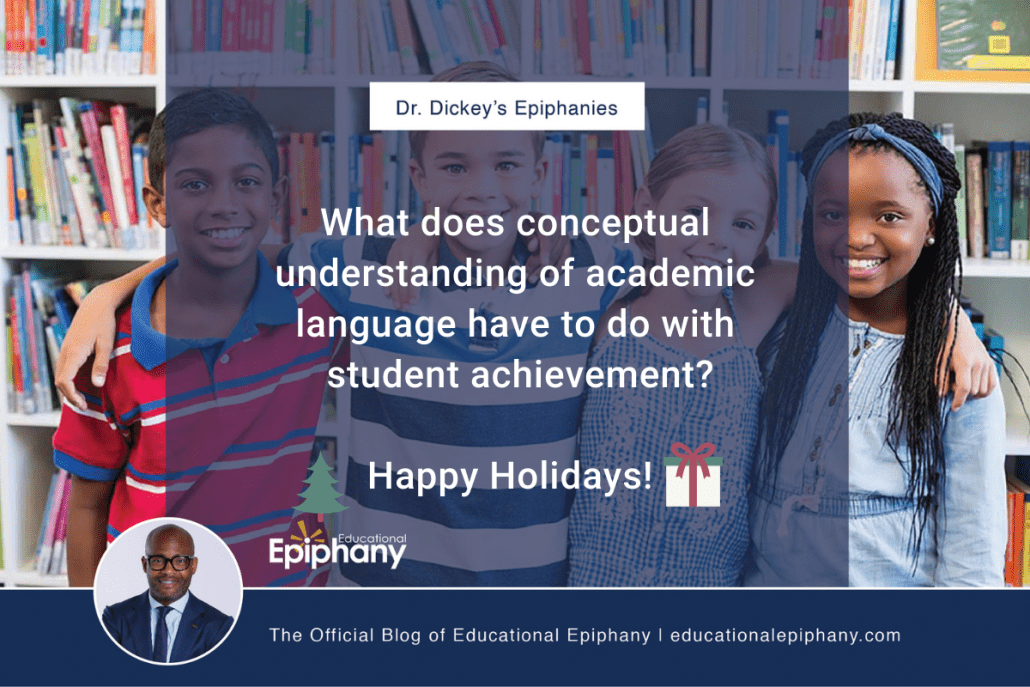Conceptual understanding of academic language is arguably the most significant accelerator of student achievement. But why is there such a lack of attention to conceptual understanding of language in classrooms across our nation? It’s a matter of exposing educators to the value of and strategies for building conceptual understanding and infusing the essential practice into instructional planning, delivering, and feedback as a default, rather than as an annoying, top-down add-on.
Let’s take a look at English/Language Arts as an example of the significance of academic language. There is a finite number of tier II vocabulary words that students will encounter as they read and perform tasks related to grade-level content. These vocabulary words are typically the same words within grade bands (i.e., prek-2, 3-5, 6-8, and 9-12), shifting somewhat in complexity between grades 2 and 3, between 5 and 6, and between 8 and 9.
Permit me to use grades 3-5 as an example. Essential tier II vocabulary words include, but are not limited to the following words and phrases:
- analyze
- author’s purpose
- author’s argument
- cite
- claim
- concept
- compare
- contrast
- determine
- key detail
- format
- identify
- integrate
- inference
- main idea
- media/medium
- phrase
- point of view
- procedure
- reasoning
- textual evidence
- text feature
- text structure
- topic
- summary
Students should be exposed to a single, operational definition of these vocabulary words so that they can subsequently and readily transfer their knowledge of the words across content areas and grade bands as they read, think, write, take formative assessments, and sit for annual standardized assessments that will undoubtedly use the aforementioned words.
The approach to teaching these vocabulary words and their definitions must become “transdisciplinary.” In order to become transdisciplinary, students must be consistently exposed to instruction that ensures the use of operational definitions that transfer across disciplines (content areas) so that students are able to demonstrate that they are “literate” irrespective of discipline. No longer can we use what some folks, with low expectations, refer to as “kid-friendly” language as definitions of these key vocabulary words. “Kid friendly” is often low expectation code for watered-down and misaligned with the standards. I would argue that it is unfriendly to kids to refrain from exposing them to the academic language of the standards, knowing well that these words will be used to pose the questions that can subsequently lock them out of proficiency and close doors in their face for years to come.
Likewise, educators should ensure that students have deep conceptual understanding of tier III vocabulary/academic language. Tier III academic language includes words that students will encounter while reading content-specific texts in an individual discipline, such as: metamorphosis, mitosis, and meiosis in a science course; or words such as: emancipation, declaration, egalitarian, and monarch in a social studies course; or words such as: gestalt, impressionism, and panoramic in an art history course. Deep conceptual understanding of tier III words is the bridge to content mastery.
To the detriment of student outcomes and in far too many classrooms, instruction on a particular concept begins and ends without students ever being exposed to the words and definitions of the words that comprise the content. How can this be? Without exception, the predecessor of content mastery is deep conceptual understanding of the academic language of the content. And by the way, asking students to copy the content-related vocabulary words from the back of the textbook is passé and does not build students’ deep conceptual understanding of unfamiliar words and phrases. The same is true for asking students to use a vocabulary word in a sentence in order to assess their deep conceptual understanding of a word or phrase. It is also worth adding that vocabulary language development is not about a “word of the day.” These practices seldom result in the language being engrafted into students’ academic lexicon.
Here is the epiphany.
Students do not conceptually understand what they have read in multi-paged texts:
- because they did not understand what they read on a particular page(s),
- because they did not understand what they read in a particular paragraph(s),
- because they did not understand what they read in a particular sentence(s), and
- because they did not understand individual words or phrases as they encountered them in a given or self-selected text.
Vocabulary development is about consistently taking advantage of curriculum-driven and in-context reading opportunities to make sense of words, as opposed to treating vocabulary development as an instructional add-on, disconnected from an authentic reading, writing, or thinking opportunity.
Many students who appear to have reading issues, actually have meaning (conceptual understanding) issues. When they are locked out of the meaning of too many words in a given text, comprehension will not take place. In other words, when students do not associate sounds with written letter patterns and create meaning on a parallel pathway as the encounter texts, they are often unable to use the texts they consume to ascend the pyramid of cognitive demand (think critically) – which is one of the main purposes of reading, whether for literary experience or for the purpose of performing a task.
For more of Dr. Dickey’s thoughts on this topic, read chapter 4 of The Integrated Approach to Student Achievement– Second Edition. The book is available exclusively on our website: www.educationalepiphany.com.
Donyall D. Dickey, Ed.D.

